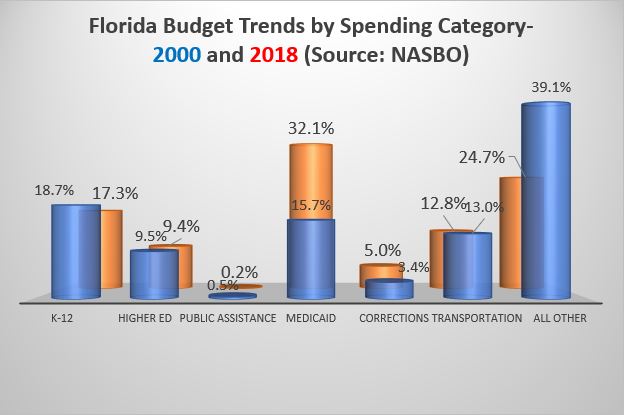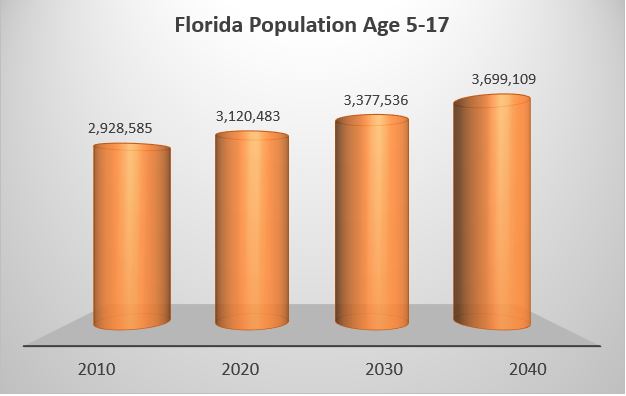
This is the state of things. Now, make your plans.
-Sophocles Antigone
Florida is getting it from both barrels of the age demographic gun – a rise in the elderly, super-elderly and youth all at the same time. On average, 10,000 Baby Boomers per day will reach the age of 65 until 2030, whereupon all surviving Boomers have reached retirement age. For the Florida economy, retirees are a way of life and benefit the state’s economy as they come in and buy condos. But the pain to the state budget hits later, when they near the end and draw upon state health care resources. This isn’t something that is going to happen, but rather something that is already well under way:
Okay so I won’t go into the gory details here. But what ought to be jumping off the chart and into your cerebral cortex is the Medicaid doubling as a percentage of the budget between 2000 and 2018, and the rest of the budget getting either flattened or reduced. That’s in no small part due to the fact that the elderly draw heavily upon Medicaid – especially the aged 85+ community, which is set to substantially increase.
Did I mention the part where EDR projects that Florida will continue to have a growing school-age population during this period as well? Well, yeah, that too.
This youth chart underestimates the scale of the challenge because Florida pays for preschool for 4-year-olds (not included above), and many 18-year-olds are still in high school. But, you get the point – Florida has hundreds of thousands of new students on the way.
According to figures provided by the Florida Department of Education, in 2016 Florida school districts spent nearly $393 million to create 14,552 new seats in district schools. EDR, however, projects a 257,053 increase in 5- to 17-year-olds between 2020 and 2030. The new seats built in 2016 will accommodate 5 percent of the 2020-2030 increase. Florida is going to need new school seats and plenty of them. But if the plan is just to spend ~$400m for 14,500 seats when you need hundreds of thousands of them, you might need a new plan.
Does Florida have a plan for recruiting the teachers it will take to accommodate 257,000 new students and replacing the retiring Boomers? The first Baby Boomer to draw a Social Security check was in 2007, but the first Baby Boomer to draw a teacher pension came earlier than that. Baby Boomer teachers are retiring, and enrollment in traditional teacher prep programs is in decline nationwide. Perhaps it would be a highly productive idea to give educators more autonomy in a context where families choose their own educational experiences. If the plan is to recruit a gigantic legion of new recruits into the teaching profession to march through curriculum scripts, you might need a new plan.
The Florida education system of 2018 was demonstrably superior to the one of 2000 across a variety of measures, including NAEP, graduation rates, K-12 students earning college credit and industrial certifications by exam, and higher education success. Hundreds of thousands of additional students enrolled in Florida schools during this period, the student body became increasingly majority minority, and academic achievement improved. Not only did you accomplish all of this, you did it with a slightly smaller share of the state’s budget (see first chart). It wasn’t easy, but you pulled it off.
Baby Boom retirement will create a whole new set of policy challenges – most prominently in health care and state pensions, but in other ways as well. Education policy alone cannot meet these challenges, nor can you meet this trial without it. Florida needs a system of education which is continually improving both academic and cost effectiveness. I’m inclined to think the only plausible path to achieving this is a decentralized process where educators are free to innovate, and families are free to reward and reject innovation.
You don’t know how to create a continually improving education system, nor do I, nor does any other individual or clique. Continual improvements in quality and cost effectiveness will require a social effort at a societal scale where educators try new things – and families try them out, keep the innovations they value and discard those they dislike. Florida needs a plan, but not of the central type. As Matthew Ridley explained:
The elite gets things wrong, says Douglas Carswell in The End of Politics and the Birth of iDemocracy, ‘because they endlessly seek to govern by design in a world that is best organized spontaneously from below.’ Public policy failures stem from planner’s excessive faith in deliberate design. ‘They constantly underrate the merits of spontaneous, organic arrangement, and fail to recognize that the best plan is often not to have one.’
We can’t be sure what schools should look like now, much less decades from now. A partnership of educators and families, however, can create the needed discovery process to improve and update education. The status quo isn’t an option. But the best plan, in my opinion, is to set educators free in a system with proper incentives – and with parents playing the primary role of holding them accountable through the tried-and-true mechanisms of voluntary association and exchange.
This is the state of things: Florida has hundreds of thousands more students and super-elderly residents on the way at the same time. Now, make your plans.




